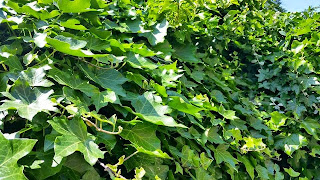 Ivy is an evergreen creeper plant that climbs up trees and walls in a search for sunlight. It is capable of surviving a range of climates and can survive in a range of soil types, which is why it can easily be found completely covering many terrains.
Ivy is an evergreen creeper plant that climbs up trees and walls in a search for sunlight. It is capable of surviving a range of climates and can survive in a range of soil types, which is why it can easily be found completely covering many terrains.Many people tend to kill ivy when they see it as they believe it is detrimental to Trees, and that they lead to the degradation of buildings. However these are myths, and this plant has a huge number of benefits for a range of wildlife.
 Ivy provides a shelter from the elements as well as for hibernation for a range of invertebrates such as Spiders, Hover flies, Froghoppers, Moths, Butterflies and many others.
Ivy provides a shelter from the elements as well as for hibernation for a range of invertebrates such as Spiders, Hover flies, Froghoppers, Moths, Butterflies and many others.Butterflies will also commonly use Ivy as an attachment point for their Chrysalises so they can develop from Caterpillars in safety from predators. Small mammals such as Mice or Voles will also use Ivy as areas to nest and to shelter in, and many small birds from Wrens, to Tits and Thrushes will build nests among the leaves.

The flowers that grow on ivy are also of great benefit to wildlife. Ivy flowers usually form during the autumn/winter months, which provides a much needed source of nectar to insect life when other flowers have disappeared. This plant will also produce berries that provide food for a range of bird life.
So if you see Ivy in your garden, or covering a tree, don't listen to the rumours that this plant is detrimental, but admire this fantastic refuge for wildlife.
-Thomas Glen
Facebook.com/goodnaturepage
No comments:
Post a Comment